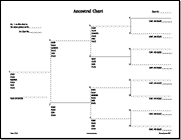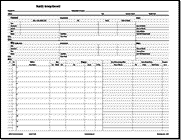|
|

|


|

|
 MODULE OBJECTIVES
MODULE OBJECTIVES

|
After successfully completing this module, you will be able to:
- Ask questions that elicit family history information from knowledgeable relatives.

- Locate home sources that provide clues about your ancestors.

- Record names, dates, places, and sources on Ancestor Charts and Family Group Sheets.



|

|
 INTRODUCTION
INTRODUCTION

|
|
|
When beginning a journey to identify your ancestors, the first step is to take out a piece of paper and write down everything you know about yourself, your parents, your grandparents, and your great-grandparents.
List dates and places of birth, marriage, and death, as well as information about places of residence, church affiliation, military service, and occupation.
When you have written down everything you know, identify other family members who might be able to fill in some of the gaps. Contact these relatives to gather more information. Ask specific questions such as:
- Where was "Grandpa Charles" born?
- Who were his parents?
- Did he have any brothers and sisters?
- Where did he live?
- What was "Grandma Shirley's" maiden name?
- When and where did they marry?
- Did your grandfather ever tell you any special stories?
- What places did you visit when you were growing up?
- What do you remember about your life during World War II?
Be sure to document who told you each piece of information.
If you audiotape or videotape an interview, start the tape with the date, location, and name of the person being interviewed.


|

|
 HOME SOURCES
HOME SOURCES

|
 When you contact your family members, ask them When you contact your family members, ask them
if they have any photographs, family bibles, letters, birth certificates, death certificates, or other family items.
Home sources such as these can provide a wealth of information.
For example, many people keep scrapbooks containing newspaper clippings of obituaries and announcements. Obituaries often reveal the residence, occupation, date of death, location of burial, and the spouse and children of the deceased.
Be creative as you look around your home (or the home of a relative) for items that might provide clues about your ancestors.
For a list of a variety of home sources, review this
checklist.


|

|
 CHARTS
CHARTS

|
As you collect more and more information, you will need to record the information in an organized fashion to keep track of the relationships.
Two important worksheets for documenting your family history are the Ancestor Chart and the Family Group Sheet.
 The
Ancestor Chart
links four or five generations in a family tree and acts as a road map of your genealogical journey. The
Ancestor Chart
links four or five generations in a family tree and acts as a road map of your genealogical journey.
When completing the chart, place the husband's name on the top line for each couple, and list the wife with her maiden name.
Record the following information for each individual:
- full name
- birth date
- birth place
- marriage date
- marriage place
- death date
- death place
 The
Family Group Sheet
is a useful chart for tracking information for each nuclear family.
The husband's full name and parents' names are listed along with the date and place of his birth, marriage, death, and burial.
Similar information is documented for the wife and for each child.
Places of residence, church affiliation, and occupation are also recorded on this worksheet.
Finally, the citation or source of each piece of information is documented on the back of the sheet. The
Family Group Sheet
is a useful chart for tracking information for each nuclear family.
The husband's full name and parents' names are listed along with the date and place of his birth, marriage, death, and burial.
Similar information is documented for the wife and for each child.
Places of residence, church affiliation, and occupation are also recorded on this worksheet.
Finally, the citation or source of each piece of information is documented on the back of the sheet.


|

|
 RECORDING INFORMATION
RECORDING INFORMATION

|
Below are some tips for completing Ancestor Charts and Family Group Sheets.

- Use a pencil until you have evidence for the information.

- List each person's full name if known.

- Indicate a nickname in quotation marks following the given name.

- Identify each female by her maiden name.

- Record dates by day, month, and year. Use the three-letter abbreviation for the month without a period ( 01 Jan 1900 ).

- To determine a birth date when you have a death date and age in years, months, and days (a common format in the 18th and 19th centuries), use this
Birth Date Calculator.

Record places as city/county/state. Use the two-letter state abbreviation ( Boston/Suffolk County/MA ).

Because many records are located at the county level, it is important to know the name of the county, as well as the name of the town, when researching your ancestors.
To determine the county in which a town is located, use this
County Boundary Database.

If you cannot determine an exact date or place, use qualifiers: by 1824, after 16 May 1938, prob (probably) in NJ.

When realistically estimating a date, use about or ca (circa).

Leave the space blank if you do not have a piece of information.


|

|
 CITING RESOURCES
CITING RESOURCES

|
As you complete each Ancestor Chart or Family Group Sheet, write down the source of each piece of information on the back of the chart.
When citing information from published sources, indicate the author, title, publisher, and page number.
For information from vital records and other genealogical resources, document where the information was found, including any microfilm numbers and certificate numbers.
Examples of some genealogical citations are listed below.
Bible Record
Marriage record for John Henry Wright and Mildred Hopkins, Holy Bible (Richmond, VA: Biblical Publishing House, 1869), p. 160, original Bible in the possession of Joseph Wilson Wright, 111 Maple Avenue, Jacksonville, FL, jwwright@earthlink.net, photocopy on file.
Birth Record
Mary Louise Rue birth record, Holmdel, Monmouth County, New Jersey, Volume Y, Page 337, New Jersey State Archives.
Book
Col. J. T. Holmes, The American Family of Rev. Obadiah Holmes, (Columbus, OH: Goodwin Publishing, 1915), p. 83.
Census Record
U. S. Census of 1870, Franklin County, Vermont, National Archives Series M593, Roll 1620, page 199B, Fairfield township, E. Fairfield post office, family number 116, household of Emery Hill.
Church Record
Marriage record for Jacob Myers and Catharine Morris, Records of the Reformed Church of Buskirk 1792 - 1942, Family History Library microfilm 534203.
Death Certificate
Ann Fletcher death certificate, #701179, Iowa Department of Public Health, Bureau of Vital Records, Des Moines, copy on file.
Probate Record
Will of Chrineyonce Schenck, #10539M, Monmouth County, New Jersey, will dated 4 Apr 1838, will proved 8 Apr 1840, New Jersey State Archives, copy in author's possession.
Interview
Interview of Esther May Harrison, 14 Aug 2008, Hickory, North Carolina, at Elizabeth Latham's home (her daughter), audiotape in author's possession.
Newspaper Article
Obituary of Alice Sue Baker, Muscatine Journal, 24 Sep 1928, p. 2.
Online Document
Interments in Rensselaer County, NY Cemeteries, online, NY GenWeb,
accessed 16 Feb 2017 at http://www.rootsweb.com/~nyrensse/cemh8.txt


|

|
 MODULE I ACTIVITIES
MODULE I ACTIVITIES

|
- Write down everything you know about yourself and your family members.
- Locate and organize home sources that may provide important information.
- Prepare a list of interview questions. Important questions include:
- What is your full name?
- When and where were you born?
- Who were your brothers and sisters?
- When and where were they born?
- Whom did they marry?
- Are they still living? (Get addresses.)
- How did you meet your spouse?
- When and where were you married?
- What is your spouse's full name and birth information?
- What are your parents' full names?
- When and where were they born?
- When and where did they marry?
- When and where were did they die?
- Where are they buried?
- Contact relatives by phone, mail, email, or in person.
If you are corresponding by mail, enclose a self-addressed, stamped envelope and a page of questions with space left for answers.
- Purchase a large three-ring binder and a box of acid-free sheet protectors.
- Print out several
Ancestor Charts
and
Family Group Sheets
and begin filling in your family information.
Be sure to document the source of each piece of information on the back of the charts.
Previous | Next
Contact Us
|

|
| 
Copyright © 2004 - 2019 by Debbie Duay, Ph.D., Fort Lauderdale, FL. All Rights Reserved.
|
| | | | |
|
|

